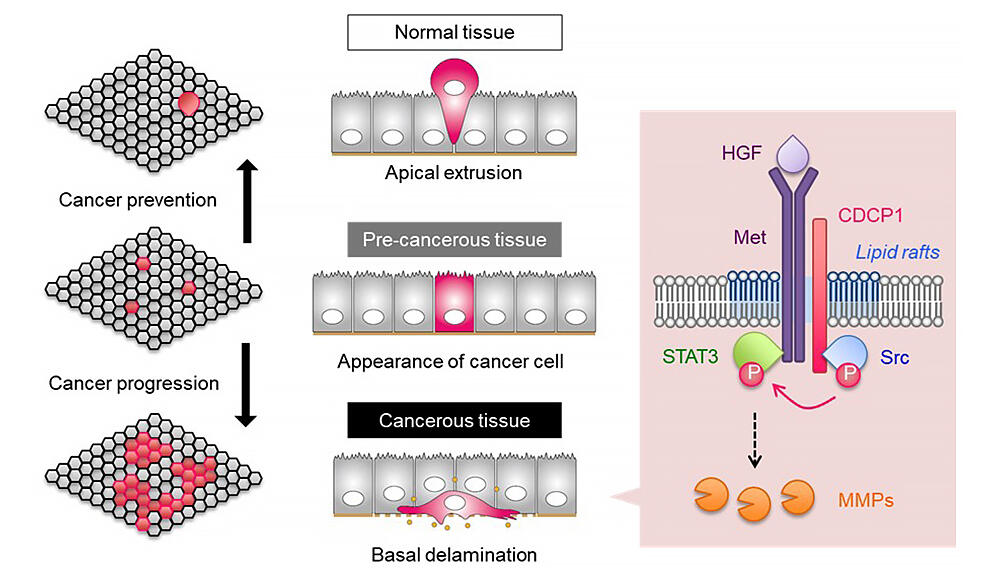Are cancer cells extruded by normal cells, or do they invade and propagate? A research group consisting of Assistant Professor Kentaro Kajiwara and Professor Masato Okada of the Research Institute for Microbial Diseases, Osaka University, and their colleagues has clarified that if Src, an oncogene product, accumulates in lipid rafts, the cell becomes invasive, but if it accumulates outside lipid rafts, the cell is extruded. They also identified the protein CDCP1, which is responsible for Src accumulation, and clarified the molecular mechanism behind this. Assistant Professor Kajiwara commented, "We are currently exploring substances that inhibit CDCP1 movement to cell membranes, and if we are able to identify one, we hope to carry out joint research with a pharmaceutical company. We have also clarified that cholesterol levels rise as cells become cancerous, and so perhaps it becomes easier for Src to accumulate in lipid rafts due to metabolism, and thus likely for cancer to worsen." Their work is published in Current Biology.

Provided by Kentaro Kajiwara, Research Institute for Microbial Diseases, Osaka University.
Cancer is thought to start when a single cell becomes cancerous, but it has become clear that in the very first phase of carcinogenesis, cancer cells are extruded by the surrounding normal cells. This is known as cell competition, and is thought to be one of the body's protection systems to prevent carcinogenesis, a separate mechanism from the immune system. However, some cancer cells beat this extrusion system, creating large cancer tissues, and finally invade the surrounding tissues.
The research group first constructed an experimental system that mimics very early-stage in vivo carcinogenesis in test tubes. More specifically, they made changes to normal cells, ensuring that cell carcinogenesis could be induced through the expression of Src, an oncogene product, and observed their behaviors in groups of normal cells. They found that although some of the cancerous cells were extruded due to cell competition, the surrounding tissues were gradually invaded from the cell layer. The invading cancerous cells did partially express the proteins that trigger the extrusion system, but these were incomplete. The group did not confirm any increased expression of proteins associated with cell competition in the surrounding normal cells. Based on these outcomes, there is a possibility that some cancerous cells evade the extrusion system and go on to become invasive.
The group then analyzed the main factors that determine the fates of cancerous cells: extrusion and invasion. When they compared two cells with different fates, they found that the location of Src accumulation in the cell membranes was different. It became clear that if Src accumulates in lipid rafts, the cell becomes invasive, and if it doesn't, the cell is extruded.
The group analyzed changes within cells in which Src accumulated in lipid rafts, and found that when this occurred, STAT3 signaling was activated. When STAT3 activation was inhibited, the invasive potential of cancerous cells was suppressed.
Next, the group analyzed the mechanism of Src accumulation in lipid rafts. When they analyzed the lipid rafts of two cells with different fates, it became clear that the proteins present were slightly different. Among these, they focused on CDCP1, as it has a clear connection to Src.
When CDCP1 was overexpressed, Src accumulated in the lipid rafts, and cells gradually became invasive. In contrast, when the group introduced mutations that ensured CDCP1 could not undergo localization in lipid rafts, Src accumulated outside lipid rafts and the cells were extruded. It is clear from these results that CDCP1 is one of the proteins responsible for the accumulation of Src in lipid rafts, and inhibiting the function of CDCP1 changes the fate of cancerous cells.
The group learned that the CDCP1 expression level increases in initial-stage carcinogenesis in lung and pancreatic cancers, and is also important to cell invasion. To paraphrase, it is a factor that contributes to a variety of processes, from the first stages of carcinogenesis to invasion, and so has the potential to be a drug discovery target not just for malignant cancers but also for initial-stage carcinogenesis.
Assistant Professor Kajiwara noted, "We had identified multiple candidates for proteins that made Src accumulate in lipid rafts. CDCP1 and Met were both included in these. These two proteins increased in cancerous cells, and other research groups had also suggested they are related to malignancy (invasive potential), so we thought of them as key targets. Moreover, coincidentally, our research on maintaining kidney functions clarified that CDCP1 works with Met to control information transmission inside cells, and is involved in kidney repair and regeneration. Thus, we analyzed cancer cell fate determination based on the knowledge clarified in our research on maintaining kidney function, and this led to an understanding of the fate determination mechanism, which was previously unknown."
Journal Information
Publication: Current Biology
Title: Src activation in lipid rafts confers epithelial cells with invasive potential to escape from apical extrusion during cell competition
DOI: 10.1016/j.cub.2022.06.038
This article has been translated by JST with permission from The Science News Ltd.(https://sci-news.co.jp/). Unauthorized reproduction of the article and photographs is prohibited.




